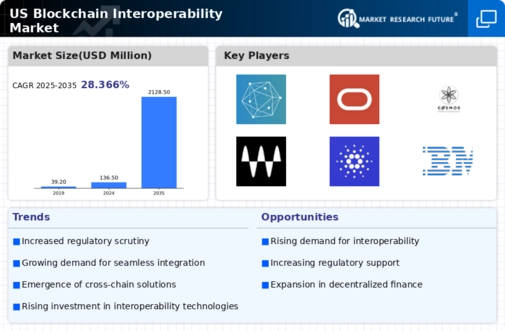The US Blockchain Interoperability Market is characterized by rapid advancements and a competitive landscape driven by a plethora of innovative players striving to create seamless connections across different blockchain networks. Given the inherent complexities of various blockchain systems, the need for interoperability has become increasingly critical, allowing for efficient data transfers, smart contract execution, and enhanced security across platforms. Major companies in this sector are continuously enhancing their offerings to cater to a growing demand for cross-chain functionality, making it easier for businesses and developers to deploy decentralized applications and blockchain solutions.
This competitive dynamic encourages firms to invest heavily in research and development while collaborating through partnerships and alliances to improve integration capabilities.
Hyperledger stands out in the US Blockchain Interoperability Market with its open-source blockchain framework that fosters collaboration among multiple stakeholders. Its core strength lies in its ability to provide a modular architecture that allows organizations to customize their blockchain solutions according to specific needs, enabling interoperability between various systems. The Hyperledger Fabric, one of its widely adopted frameworks, is specifically designed for enterprise use, providing scalability, privacy, and permissioning features that facilitate seamless interaction between different networks. The initiative's strong community support, backed by leading organizations across multiple sectors, has bolstered its presence in the market.
This collaborative approach not only enhances development capabilities but also positions Hyperledger as a trusted standard for interoperability among enterprises in the United States.
Oracle, another significant player in the US Blockchain Interoperability Market, has made a substantial impact with its robust suite of blockchain solutions aimed at enterprises. Oracle's key products, including Oracle Blockchain Platform and Oracle Cloud Infrastructure, offer comprehensive tools for building, deploying, and managing blockchain applications. Its strong market presence is further amplified by its commitment to cloud-based solutions, enabling businesses to leverage blockchain technology without extensive infrastructure investments. Oracle’s strengths lie in its established reputation in enterprise software, allowing it to integrate blockchain functionalities seamlessly into existing applications.
Additionally, Oracle has been active in strategic mergers and acquisitions to enhance its blockchain capabilities, ensuring it remains competitive in the rapidly evolving landscape. The company's focus on providing end-to-end solutions and ongoing innovation positions Oracle as a key contender in the quest for interoperability within the US blockchain ecosystem.





















